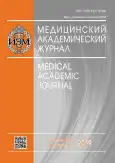ЭКСПРЕССИЯ ГЕНА БЕТА-ДЕФЕНСИНА-3 ЧЕЛОВЕКА В СЛИЗИСТОЙ ОБОЛОЧКЕ НОСА И ОКОЛОНОСОВЫХ ПАЗУХ
- Авторы: Тырнова ЕВ1
-
Учреждения:
- ФГБУ «Санкт-Петербургский научно-исследовательский институт уха, горла, носа и речи» МЗ РФ
- Выпуск: Том 19, № 1S (2019)
- Страницы: 184-186
- Раздел: Статьи
- Статья опубликована: 15.12.2019
- URL: https://journals.eco-vector.com/MAJ/article/view/19390
- ID: 19390
Цитировать
Полный текст
Аннотация
Чувствительные рецепторы сенсорной обонятельной системы локализованы в слизистой оболочке полости носа. Цель работы: оценить экспрессию гена бета-дефенсина-3 (hBD-3) в поверхностном эпителии слизистой оболочки носа и околоносовых пазух. Исследован операционный материал больных заболеваниями носа и околоносовых пазух (n = 85) (слизистая оболочка верхнечелюстных пазух, хоанальные полипы, полипы среднего носового хода, полипы верхнечелюстных пазух, нижние носовые раковины при гипертрофическом рините, нижние носовые раковины и слизистая оболочка среднего носового хода в качестве контроля). Оценку экспрессии мРНК hBD-3, а также бета-актина проводили методом обратной транскрипции и полимеразной цепной реакции в режиме реального времени. Экспрессия гена hBD-3 детектирована на низких уровнях в 14,29-33,33 % образцов, отсутствовала в гипертрофических нижних носовых раковинах (точный тест Фишера, p < 0,05 по сравнению со слизистой среднего носового хода; p < 0,01, отношение шансов (ОШ) 31,15, доверительный интервал (ДИ) 1,53÷633,6 по сравнению с полипами среднего носового хода). Самая высокая частота детекции экспрессии мРНК hBD-3 в полипах среднего носового хода (53,84 % случаев) (p < 0,05, ОШ 7,00, ДИ 1,10÷44,63 по сравнению со слизистой оболочкой верхнечелюстных пазух). Наиболее высокие уровни экспрессии гена hBD-3 также в полипах среднего носового хода (знаковый тест Вилкоксона p < 0,05 по сравнению с гипертрофическими нижними носовыми раковинами). Клинически воспалительные полипы обычно находятся в средних носовых раковинах больных хроническим риносинуситом, а не в нижних носовых раковинах. В контексте хронического воспаления, помимо прямой микробоцидной активности hBD-3 на первой линии защиты, высокие концентрации hBD-3 потенциально способствуют повреждению эпителия и фиброзному ремоделированию.
Полный текст
Об авторах
Е В Тырнова
ФГБУ «Санкт-Петербургский научно-исследовательский институт уха, горла, носа и речи» МЗ РФ
Список литературы
- Тырнова Е.В., Алешина Г.М., Янов Ю.К., Кокряков В.Н. Изучение экспрессии гена бета-дефенсина-3 человека в слизистой оболочке верхних дыхательных путей // Рос. оториноларингол. - 2015. - № 2 (75). - С. 77-84.
- Funderburg NT, Jadlowsky JK, Lederman MM, et al. The toll-like receptor 1/2 agonists Pam(3) CSK(4) and human β-defensin-3 differentially induce interleukin-10 and nuclear factor-κB signalling patterns in human monocytes. Immunology. 2011;134:151-160. https://doi.org/10.1111/j.1365-2567.2011.03475.x.
- Hariri BM, Cohen NA. New insights into upper airway innate immunity. Am. J. Rhinol. Allergy. 2016;3:319-323. https://doi.org/10.2500/ajra.2016.30.4360.
- Laudien M, Dressel S, Harder J, Gläser R. Differential expression pattern of antimicrobial peptides in nasal mucosa and secretion. Rhinology. 2011;49(1):107-111. https://doi.org/10.4193/Rhino10.036.
- Seiler F, Bals R, Beisswenger C. Function of Antimicrobial Peptides in Lung Innate Immunity. In: Antimicrobial Peptides. Birkhäuser Advances in Infectious Diseases. Ed. by J. Harder, J.M. Schröder. Springer, Cham; 2016. P. 33-52.
- White LC, Weinberger P, Coulson H, et al. Why sinonasal disease spares the inferior turbinate: An immunohistochemical analysis. Laryngoscope. 2016;126(5):E179-183. https://doi.org/10.1002/lary.25791.
Дополнительные файлы







